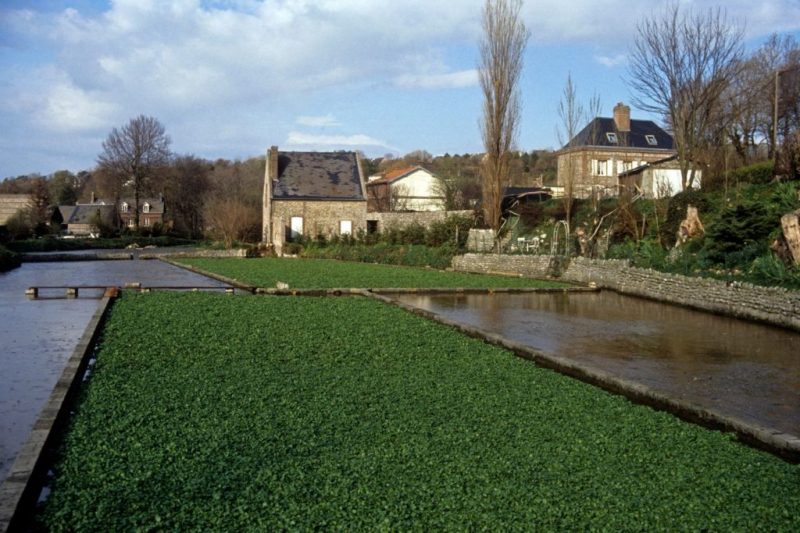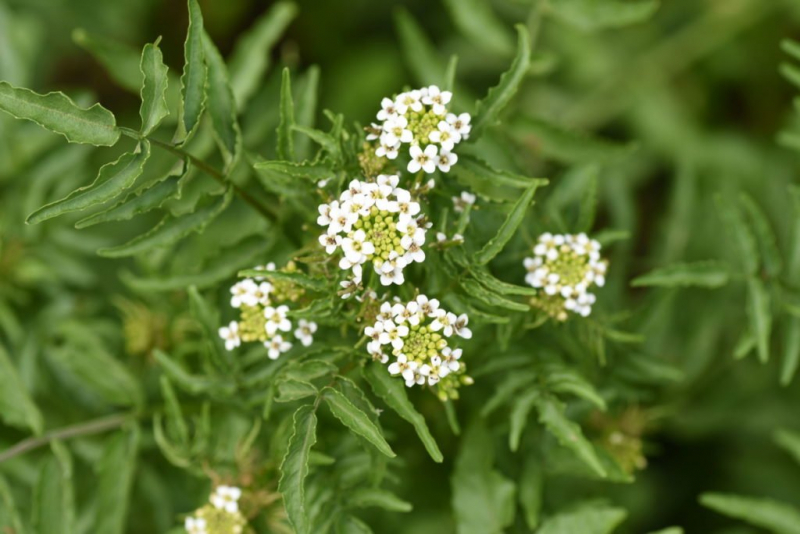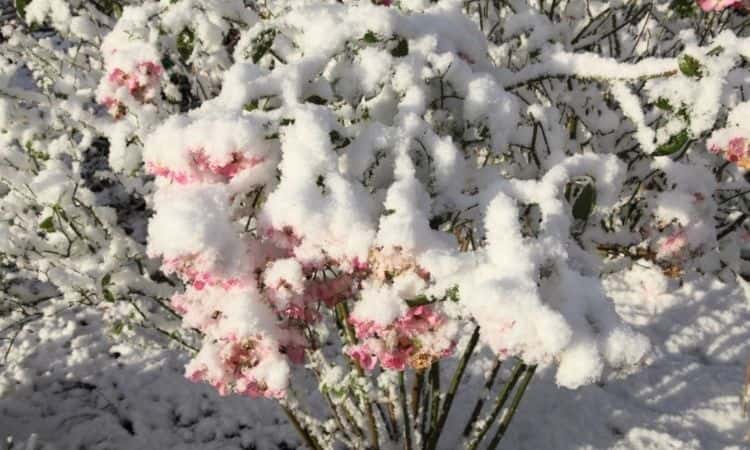Watercress Salad: Expert Tips on Growing Healthy Cress
Watercress is not only healthy, but it is also very popular as a refinement in the home kitchen. Everything you need to know about growing watercress salad can be found here. Do you remember your childhood and little Aquarius? Then you are sure to be familiar with watercress ( nasturtium ). But the healthy herb is not only on the table at Wassermanns, the watercress is also a real enrichment on the menu for us humans.
The name “watercress” has a touch of a fairy tale in it – and maybe also a touch of the past because nowadays the tasty plant is unfortunately hardly known. Wrongly, because the wild herb is much more aromatic and flavorful than the well-known garden cress ( Lepidium sativum ).
Watercress salad: origin and characteristics
Table of Contents
Despite the name relationship, the relationship to garden cress is rather extensive. Both species belong to the cruciferous family (Brassicaceae), which can be easily recognized by their four cross-shaped petals. Yet nothing connects them closer together. What they have in common, however, is their sharp, spicy taste.
As a weed along streams and springs, watercress was once widespread in Europe and tasty food for in between on long hikes, especially among nature-loving children. Today the herb, which is sensitive to pollution, is no longer so common, but it is widespread all over the world.
The plant needs a lot of moisture and grows in the shallow water of the bank areas, so it is an aquatic plant. The green stems with the fleshy leaves swim in the water or protrude from it. The plant retains its color even in winter, which is why it is often the only fresh green on the plate during the cold season.
The most popular varieties of watercress salad
Two species native to Europe belong to the genus of watercress salad ( Nasturtium). Common watercress is the real watercress ( Nasturtium officinale ), also known under the name “watercress”. This species is large and its stems are up to 90 centimeters long. One form of this species is the red watercress ( Nasturtium officinale f. Rubrum ) with its red leaves. Small-leaved watercress ( Nasturtium microphyllum ) is smaller and more compact. The sterile cross between the two species, the brown watercress ( Nasturtium x sterile ), also occurs in nature. Its leaves are bronze-like in color during the cold season.
In addition to the watercress species, there are also various varieties to be found on the market.
- Real watercress ( Nasturtium officinale ): Large growth habit.
- Red watercress ( Nasturtium officinale f. Rubrum ): Form of the real watercress.
- Small-leaved watercress ( Nasturtium microphyllum ): compact growth habit, small-leaved.
- Brown watercress ( Nasturtium x sterile ): Barren cross between real and small-leaved watercress.
Growing watercress
Watercress was once grown on a large scale by farmers. A true watercress culture has developed particularly around Erfurt, but not much has been left of it in the meantime. The cultivation is a bit cumbersome as the plant constantly requires freshwater. Nevertheless, watercress can also be grown in your own garden and even on the balcony.
You might so like: Growing Tomatoes In Raised Bed – Practical Tips With Instructions For Amateur Gardeners
When and where to plant watercress?
The most important thing for growing watercress is water. If you have a stream in your garden, then you are particularly lucky, because in this way you have the natural habitat of the watercress right on your doorstep. Otherwise, you should try to get as close as possible to the natural site. This can be achieved, for example, by means of a moat, but also in pots. The main thing is that the plant always has clear, cold, and oxygen-rich water available.
The watercress likes it sunny to partially shaded, but the plant cannot do much with the blazing summer sun. Waters that the plant colonizes in nature are usually located in a cool valley or depression.
When to plant your watercress depends on the type of planting. You can sow the aromatic plant either around March or in early August. However, it is easier to plant cuttings, which you can do in the summer.
- Cultivation in and on bodies of water, in pots, or in very humid places
- Sunny to partially shaded location, no blazing sun
- Sow in March or August
- Propagation of cuttings in summer

The correct approach to growing watercress
Before growing, you should first look for a suitable location in the garden. Ideally, this would be an existing body of water such as a stream or a pond with water circulation. If both are not available, you can of course create a water-flooded trench especially for the watercress – but that is a lot of work. An inflow and an outflow are particularly important here. The culture in the pot is simpler.
To do this, but the young watercress in a planter, preferably a bowl. Now place this in a larger container, which you fill up with water until the soil of the bowl is about one centimeter underwater. Thus, the watercress always grows in the water. However, you have to change this every two days so that the water always remains fresh and cool and also contains sufficient oxygen.
Whether in a pot or on the edge of a body of water – sowing or growing takes place without much water, but with sufficient moisture. Only when the cuttings are rooted or the seedlings have reached a sufficient size are they transplanted or flooded. However, the tips of the plant should still look out of the water.
You might so like: Balsam Apple: Location, Care And Propagation Of Clusia
A mixture of garden soil, sand, and some compost is suitable as a substrate. Depending on the location, however, this mixture must be adapted. In the pond, for example, you should not add any compost, otherwise, algae will have an easy time. In the bed and in the pot, on the other hand, humus-rich soil with a good portion of compost is advisable. While sand ensures aeration in the water-saturated pot, it is better to leave it out in the bed, otherwise, the water seeps away too quickly.
In very humid locations, watercress can also be planted in the bed – but the cress must never dry out
So the following applies to growing watercress:
- In the pond: garden or pond soil with a little sand
- In the bed: garden soil with a portion of the compost
- In the pot: garden soil with about 30% sand and a portion of the compost
Maintain watercress
Once planted, the garden cress is easy to care for. Once it has become a resident of your pond or stream, all you really need to do is harvest it. Since the plant is perennial and reproduces well under the right conditions, you don’t have to worry about the watercress’s survival either.
The whole thing looks different in the water-filled pot. It is important that you change the water every two days, otherwise the water will be depleted of oxygen, which the roots need so badly. In addition, the water becomes cloudy and enriches itself with nutrients. Watercress always needs clean and fresh water. Apart from that, the plant may need protection from the cold. Watercress is basically adapted to our temperatures, but larger bodies of water and streams do not freeze through, but a small body of water in the bucket does. If necessary, wrap the container in fleece.
A big plus of watercress salad is that it doesn’t need fertilization.
The following points are therefore important when caring for the watercress:
- Keep it moist at all times
- Change the water in the pot culture every two days
- Possibly winter protection in the bucket
- Do not fertilize
Harvesting watercress salad
The green leaves and shoots are harvested from September to around May when the plant begins to bloom. The crop can be harvested throughout the winter. To do this, you only need to cut back individual shoots. However, do not be too radical and let the plant regain its strength.
In principle, however, green parts of plants should only be harvested from flowing water. If there is no water circulation or if the water is not exchanged regularly, bacteria can accumulate on the plant. Either way, it is of course important that the harvested parts of the plant are carefully washed.
Apart from leaves and stems, flowers are also suitable for consumption and the seeds can also be used.
The flowers and buds of the watercress are a wonderful decoration for soups and salads
Watercress salad: diseases and pests
Like almost every plant, the watercress salad also has its adversaries. It is easy to spot snails that like to feast on the parts of the plant protruding from the water. Aphids ( Aphidoidea ) can also be found here from time to time. You should simply collect the former. The latter, on the other hand, can be rinsed off well with water. Wild ducks can be a problem in larger bodies of water. Then only nets or colored ribbons will help.
Apart from the representatives of the animals, the downy mildew fungus ( Peronospora parasitica ) can also be found on the watercress from time to time.
Yellow leaves on the watercress?
If the watercress gets yellow leaves, something is wrong. First of all, the most important thing to check is: Did the crop always have enough water? The water-loving plant cannot cope with a lack of water and drought. Another cause could be a root problem. A lack of oxygen or pests in the root area can cause the roots to die off.
Watercress does not bloom
The watercress blooms around May each year. In the case of freshly sown plants, it can happen that at this point in time they are still too young to flower. These plants will not begin to bloom until next year.
Watercress salad: Ingredients and Uses in Cooking
The watercress salad owes its tangy spiciness to the mustard oil glycoside gluconasturtiin. Many representatives of the cruciferous vegetables contain mustard oil glycosides. This is how the cabbage ( Brassica ) gets its typical cabbage-like smell. The taste of this mustard oil glycoside makes watercress an ideal refinement for soups and salads, but also for herbal quark and spreads. The flowers can be arranged excellently as decoration. The small seeds of the plant, on the other hand, when dried, add fresh flavor to home-baked bread.
Watercress is not only healthy but it is also considered the best type of cress among gourmets
Since watercress can also be freshly harvested in winter, it is an important supplier of vitamins A and C during the cold season. It also contains iron, iodine, and folic acid. Watercress is not only a healthy spice but also known for herbal medicine. It is considered to stimulate appetite and metabolism and is even used as an aphrodisiac. But be careful with advanced pregnancy, because too much watercress can have a labor force.






